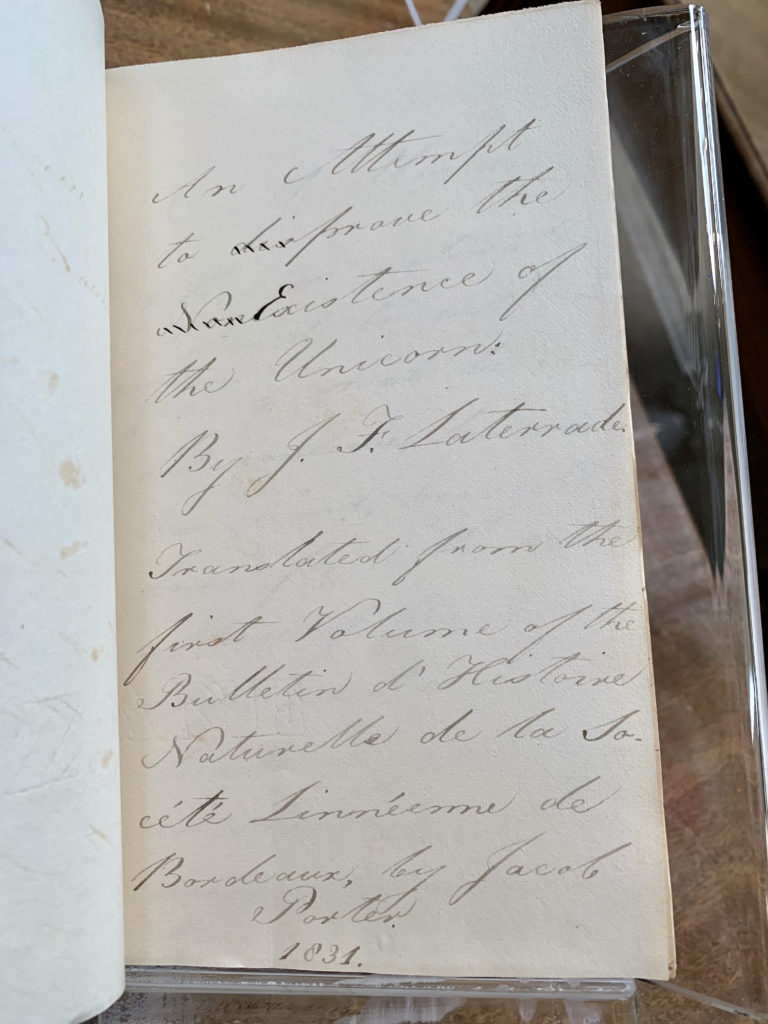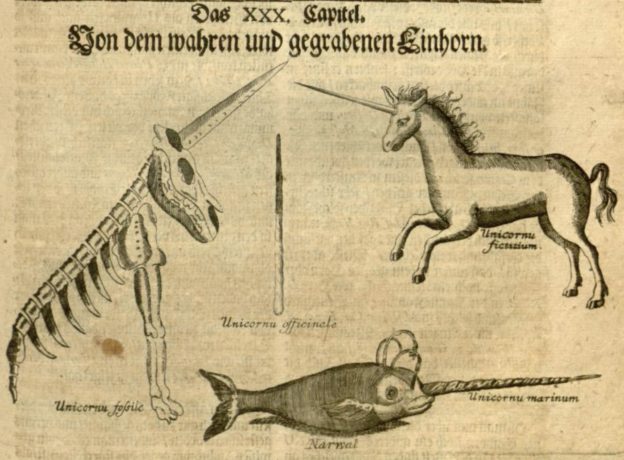There are some archival gems you can’t pass up. During my fellowship residency at the American Antiquarian Society in May 2021, AAS staff were helping me comb through the Jacob Porter Papers, when we all noticed it in the catalog record: “An Attempt to Prove the Existence of the Unicorn.”[1] “I want to believe,” someone joked as we retrieved the ‘Unicorn Treatise,’ eager to find out what it said.
My dissertation is about kitchen gardens in early America and what they tell us about non-elite people’s scientific knowledge. If there’s one thing I’ve learned while doing this research, it’s that when your archival bread and butter rests in the natural world, and especially in people’s observations about the natural world, you are bound to come across some fantastic stories. A scientific essay seeking to “prove the existence of the unicorn” might seem strange to us now, but people in the early nineteenth-century scientific community debated the existence of the unicorn, as they also debated the existence of the famous Gloucester Sea Serpent.[2] In fact, the ‘Unicorn Treatise’ reminded scholars to suspend “incredulity in natural history, which leads us to deny the existence of such species as have not come under our observation.”[3] If incredulity is the enemy of observation, then perhaps all we who study the past have a lesson to learn from the unicorn’s plight. “Wanting to believe” might in fact be the best way to enter both a unicorn’s forest and an archive. With this mentality, we can take our finds, hooved or otherwise, on their own terms.
The ‘Unicorn Treatise’ was penned by Jean-François “J.F.” Laterrade (1784-1858), a French botanist and founding member of the Linnaean Society of Bordeaux. It was printed in the first volume of the Bulletin d’Histoire Naturelle de la Société Linnéenne de Bordeaux, in 1826.[4] The treatise in the American Antiquarian Society collections is Jacob Porter’s handwritten version. Porter (1783-1846) was a Yale graduate, Massachusetts physician, and member of the Lyceum of Natural History of New York.[5] His English translation of Laterrade’s treatise was published in the American Journal of Science and Arts in 1832.[6]
 Filtered through the lens of Porter’s translation, Laterrade’s treatise offers a threefold defense of the unicorn – and of belief in what may at first seem inconceivable. First, he seeks to prove that the “land unicorn” – distinguishing it from the narwal – “has in it nothing remote from the ordinary laws of nature.” Since the unicorn primarily resembles a common horse, Laterrade supposes that the sticking point must be its horn. “But then,” he conjectures, surely the narwal’s horn is “far less natural” than that of a unicorn, since narwals are creatures of the sea.[7] Second, Laterrade cites historic references to the unicorn, from “David and the prophets;” to the Roman natural philosopher Pliny the Elder; to a unicorn skeleton discovered in 1663 in Quedlinburg (now Germany), and “sent to the princess Abbesse.”[8] Because “several authors have made mention” of the unicorn, Laterrade wonders what further objection there can be. He allows that historically there have been some “ridiculous” beliefs about the properties of unicorn horns but that such “falsehood or ignorance” should not cause scholars to reject “real facts.”[9] Third, Laterrade counters the argument that because “moderns have never seen [unicorns],” they must not exist. As with discoveries of “the mammoth,” and “shells, the inhabitants of which we have not yet been able to determine,” Laterrade contends “that nature loses nothing by growing old.” And that in fact, “what animal is [not] a little extraordinary…when the might of time has removed it a little distance from us?” In the end, Laterrade does not say definitively that the unicorn exists. He concludes merely that there is “satisfactory evidence” that the unicorn existed, and that possibly “he exists still.”[10]
Filtered through the lens of Porter’s translation, Laterrade’s treatise offers a threefold defense of the unicorn – and of belief in what may at first seem inconceivable. First, he seeks to prove that the “land unicorn” – distinguishing it from the narwal – “has in it nothing remote from the ordinary laws of nature.” Since the unicorn primarily resembles a common horse, Laterrade supposes that the sticking point must be its horn. “But then,” he conjectures, surely the narwal’s horn is “far less natural” than that of a unicorn, since narwals are creatures of the sea.[7] Second, Laterrade cites historic references to the unicorn, from “David and the prophets;” to the Roman natural philosopher Pliny the Elder; to a unicorn skeleton discovered in 1663 in Quedlinburg (now Germany), and “sent to the princess Abbesse.”[8] Because “several authors have made mention” of the unicorn, Laterrade wonders what further objection there can be. He allows that historically there have been some “ridiculous” beliefs about the properties of unicorn horns but that such “falsehood or ignorance” should not cause scholars to reject “real facts.”[9] Third, Laterrade counters the argument that because “moderns have never seen [unicorns],” they must not exist. As with discoveries of “the mammoth,” and “shells, the inhabitants of which we have not yet been able to determine,” Laterrade contends “that nature loses nothing by growing old.” And that in fact, “what animal is [not] a little extraordinary…when the might of time has removed it a little distance from us?” In the end, Laterrade does not say definitively that the unicorn exists. He concludes merely that there is “satisfactory evidence” that the unicorn existed, and that possibly “he exists still.”[10]
More compelling to Laterrade than a neat proof – unicorns or no unicorns – was a disarming of narrow-mindedness. The last paragraph of the ‘Unicorn Treatise’ quotes Georges-Louis Leclerc, Comte de Buffon’s Histoire Naturelle: “It is necessary to consider nothing as impossible, to look for every thing, and to suppose that whatever can exist, really does.”[11] Over and over, this is also Laterrade’s refrain. In the pursuit of knowledge, Laterrade insists, “[L]et us examine attentively and judge with impartiality.” Let us consider all possibilities, including those beyond our “exact sphere” of understanding.[12] Archival finds like the ‘Unicorn Treatise’ remind me to approach sources with an open mind. Often, the more interesting question to ask myself is not “was it real?” but “why was it a possibility for the people I study?” I want to believe.
[1] “An Attempt to Prove the Existence of the Unicorn,” Mss boxes P, box 3, Jacob Porter Papers, 1802-1846, American Antiquarian Society, Worcester MA.
[2] In the original publication of the ‘Unicorn Treatise,’ author Jean-François Laterrade explains in a footnote that he was convinced to publish the treatise after observing renewed interest in the unicorn in the scientific community. J.-F. Laterrade, “Notice en Réfutation de la Non Existence de la Licorne,” Bulletin d’Histoire Naturelle de la Société Linnéenne de Bordeaux 1 (1826): 186. Less than a decade before the ‘Unicorn Treatise’ was first published, many people sighted a sea monster in Gloucester Harbor, Massachusetts, prompting members of the Linnean Society of New England to visit to see for themselves. Chandos Michael Brown, “A Natural History of the Gloucester Sea Serpent,” American Quarterly 42, no. 3 (September 1990): 402-436.
[3] “An Attempt,” Jacob Porter Papers, AAS.
[4] Laterrade, “Notice en Réfutation,” 186-192.
[5] Biographical information from the Jacob Porter Papers catalog entry, American Antiquarian Society website, https://catalog.mwa.org/vwebv/holdingsInfo?bibId=271994.
[6] J.F. Laterrade, “An Attempt to Prove the Existence of the Unicorn,” trans. Jacob Porter, The American Journal of Science and Arts 21 (January 1832): 123-126.
[7] “An Attempt,” Jacob Porter Papers, AAS.
[8] “An Attempt,” Jacob Porter Papers, AAS. The “princess Abbesse” may refer to the Princess-Abbess of Quedlinburg at the time, Anna Sophia I.
[9] It was believed that unicorn horns could detect poison and cure a wide range of other maladies.
[10] “An Attempt,” Jacob Porter Papers, AAS.
[11] Laterrade refers to Comte de Buffon, Histoire Naturelle, Générale et Particulière, Avec la Description du Cabinet du Roi, published in several volumes beginning in 1749.
[12] “An Attempt,” Jacob Porter Papers, AAS.
 Holly Gruntner is a PhD candidate in the Harrison Ruffin Tyler Department of History at William & Mary. She holds an MA in History from William & Mary and a BA from the University of Minnesota-Morris. Holly’s dissertation is titled, ‘“Some People of Skil and Curiousity’: Kitchen Gardens and Scientific Knowledge in Early America.”
Holly Gruntner is a PhD candidate in the Harrison Ruffin Tyler Department of History at William & Mary. She holds an MA in History from William & Mary and a BA from the University of Minnesota-Morris. Holly’s dissertation is titled, ‘“Some People of Skil and Curiousity’: Kitchen Gardens and Scientific Knowledge in Early America.”
Her research uses kitchen gardens as a lens through which to view non-elite people’s intellectual lives and work, and the ways in which they fed broader scientific conversations in the long eighteenth century.


One thought on “A Unicorn in the Archives”